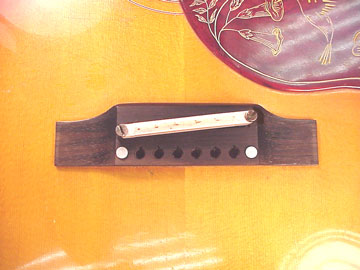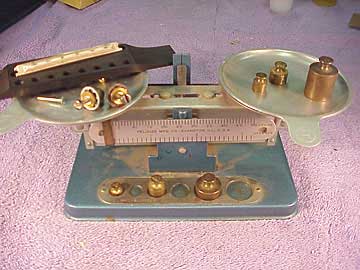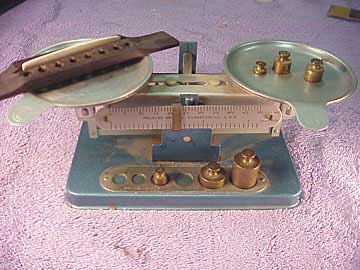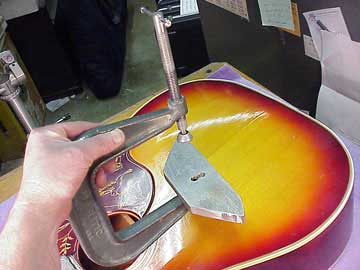A Bridge Upgrade
© Frank Ford, 1/1/99; Photos by FF, 1/1/99
OK, here's where I get into trouble, but I just can't resist saying that this Gibson Hummingbird has a bad bridge:

It's bad because it's adjustable and the extra mass of the adjusting hardware impedes vibration. It's bad because it was never well glued to the top. It's bad because it has bolts right in line with the bridge pins, and that increases the likelihood of a crack forming through this vulnerable area.
It's bad because the line of bridge pins is right at the back edge where all the stress of the string tension is concentrated, and there's such a tiny margin of wood behind the pins it can barely hold on to the top.
And finally, it's bad because it has a ceramic saddle which weighs enough to be an effective mute all by itself.
Now, I feel better. . .
After all that, I must say that these are only my opinions, and I have no argument with anyone who likes the sound of a guitar with this bridge on it. Besides, this is a pricey job, and if it hadn't been for the structural problems, the owner of this guitar probably wouldn't have chosen to make the "upgrade."
Let's take a look at this bridge up close:

As you can see, the bridge is peeling away from the top. The glue has failed completely probably as a result of exposure to heat, and only bridge pins and the two bolts are holding things together. Additionally, the top is bulging quite a lot just behind the bridge.
After removing strings and the nuts from underneath, the bridge simply dropped off.
Now, take a look at all this hardware:

Here you have a regular size rosewood bridge and a wide ceramic saddle. That metal strip is a piece of spring steel placed under the saddle. I guess it's supposed to cut down on rattles, but without the strip these bridges don't rattle, so I figure it's useless. Then there are the screw adjusters to raise and lower the saddle. These screw into brass implants which themselves are bolted through the top and bridge plate.
Just the metal hardware alone weighs enough to make a fairly substantial mute.
The whole business together tips the scale at 65 grams:

While a complete conventional nonadjustable bridge weighs in at 23.3 grams:

The bottom line is that by switching from the ceramic saddle adjustable bridge, we can save a solid 40 grams of mass, or 65% of the original.
I generally don't recommend hotrodding instruments, especially when the results are subtle to the degree of being just marginal. But any time you can reduce the mass of an overweight bridge by two thirds, you're bound to be able to notice the improvement in volume and tone.
